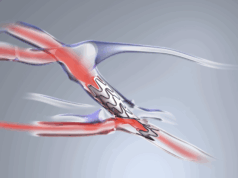
At CX35 (6–9 April, London, UK), Cees Wittens, Maastricht, The Netherlands, presented his experience with stents for deep vein occlusive disease. He told delegates that the ideal device should offer high radial force and high flexibility.
Wittens stated that stenting is indicated for intraluminal-extraluminal occlusive disease, and can be performed in inferior vena cava, common iliac vein, external iliac vein and common femoral vein. In the common femoral vein, he said, the use of a stent depends on “how far down it is possible to go depending on the quality of the stent and the severeness of the disease”.
With regards to the requirements for stents per venous segment, Wittens told delegates that in the inferior vena cava high radial force is necessary and high flexibility is not mandatory. However, he added, in the common and external iliac veins, high radial force and especially high flexibility are needed.
“There are shortcomings of stents currently available. We used multiple stents, with different properties, with some being stronger and/or more flexible, and these differences influence outcomes. You can have complications due to a low radial force or high rigidity like; stent compression, kinking, tapering, and fracturing,” he said.
Wittens said that stents that have been used in the venous system are the Boston Scientific Wallstent, Cook Medical Zilver Vena, and the Sinus XL stent from Optimed. A new device, the Sinus Venous also from Optimed, is a segmental stent with higher flexibility and radial force, he told delegates. “Another device, the Veniti stent, is not available in Europe yet, and has also a high radial force but is less flexible. The Zilver Vena stent is more flexible, but has a lower radial force,” he said.
He went on to show examples of implantation of the new Sinus Venous stent and present data on the use of venous stents. He showed results comparing the use of stents used in 2012 (Sinus XL, Wallstent, Zilver Vena and Andra) and the new Sinus Venous, which his centre started to use this year. With the 63 stents implanted in 2012, at a mean follow-up of eight months, the primary patency rate was 74.3%. The patency after primary assisted intervention was 81.4% and patency after secondary intervention was 87.3%. The reintervention rate was 20.6%. In 2013, with the Sinus Venous stent implanted in 35 patients so far, at a three-month follow-up, the primary patency rate was 88.6% (p<0.05), and patency after secondary intervention was 97.1%. The reintervention rate with the new stent was 8.6% (p<0.05).
“In our series of more than 200 patients we have seen that in the first half year the problems after stenting are mostly related to stent design and inflow and outflow. We hope this new stent will help us improve outcomes,” Wittens stated.
In his conclusion, he said that new dedicated venous stents are available and now more results with the Zilver vena device are awaited and the launch of the new Veniti device in Europe is expected. He added that the new Sinus Venous device has shown better short term primary and secondary patency, easy deployment and positioning, high flexibility with good alignment and high radial force.












